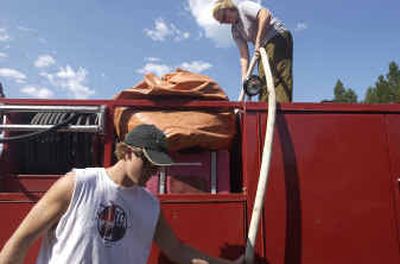Wildfire conditions reach extreme levels

Wildfire conditions are extreme in much of the region’s fields and forests, but a lack of lightning and careless behavior have kept things mostly quiet during fire season’s dawn.
Don’t expect the luck to hold, firefighters say.
The relatively wet spring has created an abundance of brush and grass, which now is being baked into flash fuels. And the spring rains weren’t heavy enough to penetrate the biggest logs that have been dried by five years of drought, said Carl Wright, fire management officer for the U.S. Forest Service’s ranger district in Newport, Wash.
“The stage is being set,” Wright said. “If you get a fire in heavy fuels, it’s probably going to burn pretty good.”
Campfires are still allowed in North Idaho, but burn permits are no longer being issued, and all burning has been banned in Spokane County. Small bonfires within steel rings are allowed in designated federal campgrounds in the region.
July was drier and hotter than usual, and that pattern is expected to continue in August, said Ron Miller, a meteorologist with the National Weather Service office in Spokane. Three-quarters of an inch of rain typically falls in Spokane during the month. The 0.08 inch that fell was barely enough to dampen the bottom of rain gauges.
Temperatures were also 3 1/2 degrees above normal for the month, Miller said. The current heat wave is expected to hold through the weekend, but cooler weather should arrive early next week. Along with it comes a chance for rain – and lightning.
Firefighters across the region were sent scrambling in late June when a series of storms rolled through, raking the Inland Northwest with hundreds of lightning strikes. One of the storm fronts sparked more than 300 wildfires, including the fires still burning near Lake Chelan, said Scott Boyd, fire management officer for the Bureau of Land Management.
July’s heat and dryness will only magnify the ignition power of a single thunderstorm, Boyd said. “So far it’s been fairly slow for us. But that’s subject to change.”
The slow start to fire season has been a surprise, said Pat Humphries, with Spokane County Fire District 4.
A handful of small fires in the Deer Park and Mount Spokane areas have been fairly easily contained.
“Things aren’t as bad as anticipated earlier in the year, but a couple weeks of this weather will change that,” he said, adding that fire season typically lasts into October.
Many of the region’s firefighters have been sent to Alaska, which is experiencing one of the worst fire seasons on record.
The crews now are returning home, which will help ensure a quick response to fledgling fires, said Mike Denney, area supervisor at the Idaho Department of Lands office in Coeur d’Alene.
“We’re sitting pretty good.”
All it would take, though, is a single storm or tossed cigarette butt to quickly change things, Denney added. “We’re at that breaking point right now because of all the dry weather and winds.”